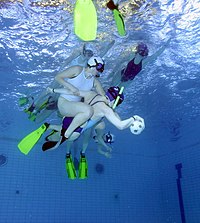
Photo from wikipedia
Cummins, C, Charlton, G, Naughton, M, Jones, B, Minahan, C, and Murphy, A. The validity of automated tackle detection in women's rugby league. J Strength Cond Res XX(X): 000-000, 2020-This… Click to show full abstract
Cummins, C, Charlton, G, Naughton, M, Jones, B, Minahan, C, and Murphy, A. The validity of automated tackle detection in women's rugby league. J Strength Cond Res XX(X): 000-000, 2020-This study assessed the validity of microtechnology devices to automatically detect and differentiate tackles in elite women's rugby league match-play. Elite female players (n = 17) wore a microtechnology device (OptimEye S5 device; Catapult Group International) during a representative match, which involved a total of 512 tackles of which 365 were defensive and 147 were attacking. Tackles automatically detected by Catapult's tackle detection algorithm and video-coded tackles were time synchronized. True positive, false negative and false positive events were utilized to calculate sensitivity (i.e., when a tackle occurred, did the algorithm correctly detect this event) and precision (i.e., when the algorithm reported a tackle, was this a true event based on video-coding). Of the 512 video-derived attacking and defensive tackle events, the algorithm was able to detect 389 tackles. The algorithm also produced 81 false positives and 123 false negatives. As such when a tackle occurred, the algorithm correctly identified 76.0% of these events. When the algorithm reported that a tackle occurred, this was an actual event in 82.8% of circumstances. Across all players, the algorithm was more sensitive to the detection of an attacking event (sensitivity: 78.2%) as opposed to a defensive event (sensitivity: 75.1%). The sensitivity and precision of the algorithm was higher for forwards (sensitivity: 81.8%; precision: 92.1%) when compared with backs (sensitivity: 64.5%; precision: 66.1%). Given that understanding the tackle demands of rugby league is imperative from both an injury-prevention and physical-conditioning perspective there is an opportunity to develop a specific algorithm for the detection of tackles within women's rugby league.
Journal Title: Journal of Strength and Conditioning Research
Year Published: 2020
Link to full text (if available)
Share on Social Media: Sign Up to like & get
recommendations!